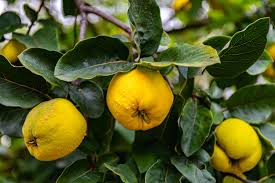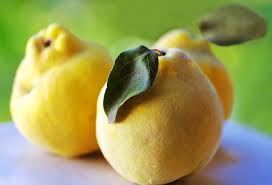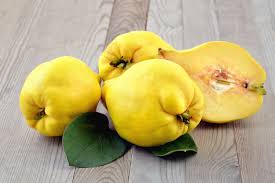Quinces, scientifically known as Cydonia oblonga, are fascinating fruits that have captivated human taste buds for centuries. Originating from the Caucasus region of Eurasia, these golden-hued wonders belong to the Rosaceae family, making them relatives of apples and pears.
Renowned for their distinct aroma and unique flavor, quinces possess a delightful blend of sweet and tart notes. Their irregularly shaped appearance may deceive the eye, but it is their captivating taste that truly distinguishes them in the world of fruits.
These ancient fruits have earned their place in history, often mentioned in various culinary and literary works. From ancient Greece, where quinces were a symbol of love and fertility, to medieval Europe, where they were incorporated into elaborate dishes, these fruits have left an indelible mark on cultural and culinary landscapes.
Quinces boast a tough and astringent flesh when raw, which transforms into a velvety, fragrant delight when cooked. Many enthusiasts cherish the process of transforming these unassuming fruits into jams, jellies, or compotes, unlocking their full potential.
Not only are quinces celebrated for their culinary versatility, but they also bring a touch of elegance to gardens with their delicate blossoms. The Cydonia oblonga tree, adorned with pale pink flowers, is a picturesque addition to any landscape, adding aesthetic value beyond its culinary contributions.
In addition to their flavorful profile and aesthetic appeal, quinces offer nutritional benefits. Packed with vitamin C, fiber, and antioxidants, these fruits contribute to a well-rounded and health-conscious diet.
As time marches on, quinces continue to hold a special place in the hearts and kitchens of those who appreciate the finer aspects of culinary exploration. Whether enjoyed fresh, cooked into delectable dishes, or admired in the garden, quinces remain a timeless fruit, reminding us of the rich tapestry of flavors and traditions that weave through the history of food.
Read Also: Introduction to Rabbit Rearing
The History of Quinces Fruits

The history of quinces, those golden treasures of the fruit world, stretches back through the annals of time, entwined with the stories of various civilizations and cultures. Scientifically known as Cydonia oblonga, these fruits have left their sweet and aromatic imprint on the tapestry of human culinary heritage.
Originating from the Caucasus region of Eurasia, quinces found a place in the gardens of ancient civilizations. The Greeks, enamored by their fragrance and symbolic significance, considered quinces as tokens of love and fertility. The esteemed physician Hippocrates even documented the medicinal properties of quinces, recognizing their potential health benefits.
In medieval Europe, quinces gained popularity not only for their taste but also for their versatility in the kitchen. They became stars in elaborate dishes, often featuring in pies, tarts, and savory concoctions. The journey of quinces across continents continued with the expansion of trade routes during the Renaissance, further embedding them in the culinary traditions of diverse cultures.
During the colonial era, quinces made their way to the New World, where they found a new audience and adaptation into local cuisines. As the industrial revolution transformed food production, quinces took on new roles, becoming staples in preserves, jams, and jellies, preserving their delightful essence for year-round enjoyment.
While quinces may have faded from the everyday fruit bowl in the modern era, they persist as hidden gems cherished by those who appreciate their unique flavor and culinary potential. Today, these fruits continue to grace gardens and orchards, connecting us to a rich history of cultivation and culinary exploration.
In the grand narrative of food history, quinces stand as resilient characters, surviving the tides of changing tastes and culinary trends. Their journey, from ancient symbolisms to contemporary delicacies, reflects the enduring appeal of these unassuming fruits, reminding us that the past flavors the present, and the essence of quinces remains an integral part of our gastronomic heritage.
Nutritional Value of Quinces

Quinces, those golden orbs of culinary delight, not only captivate the taste buds but also offer a bounty of nutritional benefits. Rich in essential vitamins, minerals, and antioxidants, quinces contribute to a well-rounded and health-conscious diet.
One standout feature of quinces is their high vitamin C content, a potent antioxidant known for its immune-boosting properties. This vitamin plays a crucial role in supporting the body’s defense against infections and promoting overall skin health.
Quinces are also a good source of dietary fiber, aiding in digestion and promoting a healthy gut. The fiber content contributes to a feeling of fullness, potentially assisting in weight management and supporting digestive regularity.
These fruits contain various minerals, including potassium, which plays a vital role in regulating blood pressure and supporting cardiovascular health. Additionally, quinces provide smaller amounts of minerals like copper, iron, and magnesium, which contribute to various physiological functions within the body.
The antioxidants found in quinces, such as phenolic compounds, contribute to their overall health-promoting properties. Antioxidants help combat oxidative stress, which is linked to various chronic diseases and the aging process.
While quinces are not typically consumed in large quantities due to their astringent taste when raw, they shine in culinary creations like jams, jellies, and cooked dishes. These preparation methods not only enhance their flavor but also unlock the nutritional benefits within, making quinces a delightful and healthful addition to a diverse and balanced diet.
In addition, quinces offer a nutritional profile that includes vitamin C, dietary fiber, and an array of essential minerals. Whether enjoyed fresh or incorporated into various culinary delights, quinces provide a unique and wholesome contribution to the spectrum of fruits available for a nutritious and flavorful diet.
Read Also: The Production and Marketing of Bush-Meat
Health Benefits of Quinces

Quinces, with their unique flavor and versatility, bring more than just culinary delight – they also offer a range of health benefits.
1. Immune Support: Quinces are rich in vitamin C, a potent antioxidant that plays a crucial role in supporting the immune system. Regular consumption may help the body defend against infections and illnesses.
2. Digestive Health: The high fiber content in quinces promotes digestive health. Fiber aids in maintaining regular bowel movements, preventing constipation, and supporting a healthy gut microbiome.
3. Heart Health: Quinces contain potassium, a mineral that supports heart health by helping to regulate blood pressure. Maintaining a balanced potassium level is essential for cardiovascular well-being.
4. Antioxidant Protection: The presence of various antioxidants in quinces, such as phenolic compounds, helps combat oxidative stress. Antioxidants contribute to overall cellular health and may reduce the risk of chronic diseases.
5. Skin Health: Vitamin C, found abundantly in quinces, is essential for collagen synthesis, promoting skin elasticity and resilience. Including quinces in your diet may contribute to a healthy and radiant complexion.
6. Weight Management: The fiber in quinces contributes to a feeling of fullness, potentially aiding in weight management by curbing excessive calorie intake and promoting satiety.
7. Nutrient Boost: Quinces provide a range of essential minerals, including copper, iron, and magnesium. These minerals play vital roles in various physiological functions, such as blood formation and enzyme activity.
8. Anti-Inflammatory Properties: Some compounds in quinces have anti-inflammatory properties, which may contribute to reducing inflammation in the body. Chronic inflammation is associated with several health issues.
While enjoying the health benefits of quinces, it’s essential to note that individual dietary needs vary. Incorporating a diverse range of fruits and vegetables, including quinces, into a balanced diet contributes to overall well-being. As with any dietary changes, consulting with a healthcare professional is advisable, especially for individuals with specific health concerns or conditions.
How to Grow Quinces Fruits (Growing Guide)
Growing quinces can be a rewarding endeavor, offering not only a bountiful harvest but also the pleasure of cultivating a unique and versatile fruit. Here’s a simple guide to help you grow quinces:
1. Choosing the Right Location: Quince trees thrive in full sunlight. Choose a location with at least 6 to 8 hours of direct sunlight daily. Ensure well-draining soil with a slightly acidic to neutral pH.
2. Planting Quince Trees: Plant quince trees in late winter or early spring when the tree is still dormant. Dig a hole that is as deep as the root ball and twice as wide. Place the tree in the center and fill the hole with soil.
3. Watering: Quinces require regular watering, especially during dry spells. Keep the soil consistently moist but not waterlogged. Provide a layer of mulch around the base of the tree to help retain moisture and suppress weeds.
4. Pruning: Prune quince trees in late winter or early spring before new growth begins.
Remove dead or damaged branches and thin out crowded growth to improve air circulation. Shape the tree to encourage an open canopy.
5. Fertilizing: Apply a balanced fertilizer in the spring before new growth starts. Follow package instructions for proper application.
6. Pollination: Quince trees are often self-pollinating, but planting more than one tree can improve fruit set. Bees and other pollinators play a crucial role, so encourage biodiversity in your garden.
7. Pest and Disease Management: Keep an eye out for common pests such as aphids or scale insects. Treat infestations promptly. Provide good air circulation and avoid overhead watering to prevent fungal diseases.
8. Harvesting: Quinces are typically ready for harvest in late autumn. Wait until the fruit turns from green to yellow and gives slightly to pressure. Harvest with pruning shears, leaving a small portion of the stem attached to the fruit.
9. Storage: Store harvested quinces in a cool, dark place. They can last for several weeks when stored properly. Growing quinces may take some patience, as they can take a few years to start bearing fruit. However, with proper care and attention to their needs, you can enjoy the satisfaction of growing these versatile and flavorful fruits in your own backyard.
Read Also: CBD Oil – Uses, Health Benefits and Risks
